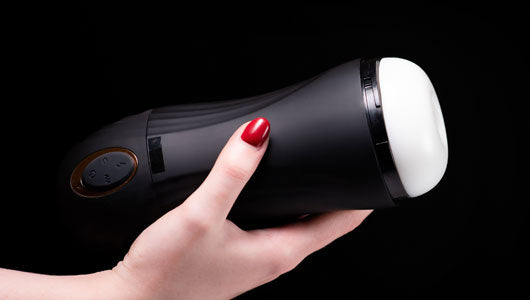
How To Clean and Dry a Stroker
Just got a stroker? Not sure how to clean it? Well, there's a lot of conflicting information out there. Some people say to use soap, others say never use soap, and some say anything but water is a no-go. So, who's right? And does the type of material make a difference?
Read on. I'll cut through the confusion and tell you how to care for your silicone or TPE/TPR stroker. I'll also explain why drying your stroker is just as important as keeping it clean and reveal the one tool that makes the drying process a cinch.
Why Clean Your Stroker?
First things first. Why is cleaning a stroker so important? Obviously, you want to remove body fluids and lube between uses. But there are other reasons, too.
Cleaning helps to wash away any pathogens that live on the skin. This is particularly crucial in the case of strokers made from TPE (thermoplastic elastomer) because TPE is a porous material that absorbs bacteria. The more you remove from the surface, the less will be absorbed.
Silicone is a non-porous material that doesn't absorb bacteria. But this doesn't mean that bacteria can't build up on the surface of a silicone toy. Silicone can also absorb odors over time, making a thorough cleaning key to a fresh and odor-free stroker.
Before we dive into cleaning methods, keep in mind that it's always a good idea to follow the manufacturer's care instructions that came with your stroker. If your stroker doesn't have instructions or you've tried them and they aren't sufficient, then the following could be very helpful.
Let's start with the most common stroker material: TPE.
How To Clean a TPE Stroker
TPE strokers are known for their pleasurably squishy feel and stimulating texture. But cleaning them can be a challenge. Here's why: TPE is softened with mineral oil and other compounds that make it vulnerable to soaps and high temperatures.
This means that simple cleaning methods and low water temps are the way to go to help preserve your stroker. Though instructions for your specific stroker may vary, here are some basic instructions that work for just about any TPE penis toy:
- Always wash a new sex toy before using it
- Avoid bar soap, liquid hand soap, body wash, or dish soap. Some people use Dawn dishwashing detergent to clean their sex toys, but the chemicals and fragrances in Dawn can harm TPE and other sex toy materials
- Never boil a TPE stroker, put it in the dishwasher, or use hot water to clean it. This holds true even if the toy doesn't contain a motor or plastic parts
- Rinse your stroker thoroughly before cleaning it. Some stroker manufacturers such as Tenga suggest using only water to clean your stroker
- Use a sex toy cleaner if your manufacturer suggests it. Some companies, like Fleshlight, have their own branded toy cleaning spray
- If water alone doesn't feel sufficient, consider alcohol. Some stroker users clean their toys with a 70% isopropyl alcohol solution and then let them dry
For a complete guide to cleaning all of your sex toys, including strokers, check out How To Clean Your Sex Toys
How To Dry a TPE Stroker
Drying a TPE stroker can be a challenge, particularly if one end is closed and the lining has a complex texture. Because TPE is porous and can harbor mildew, it's important to dry your toy completely.
Here are a few techniques for removing all water from your stroker and keeping it in good condition:
- Turn the sleeve of your stroker inside out, clean and rinse it thoroughly and use a clean microfiber towel to dry it as much as possible. Leave it turned inside out to finishing air drying
- After rinsing your stroker, insert a drying rod made from diatomaceous earth into the stroker to absorb water. A drying rod can make the difference between a stroker that take hours or even days to dry and one that dries quickly
- If you can't turn your stroker inside out, try rolling up a microfiber cloth and inserting it into the toy. Squeeze the sides of the stroker to help push the water droplets into the towel. Leave towel inside the stroker for an hour and then take it out. Check for leftover moisture with your finger before putting the toy away
- Wash and rinse your stroker. Leave both ends open as wide as possible and set the toy in front of a desktop fan until dry. The fan method can help dry shorter or open strokers but is unlikely to dry a longer stroker unless it's turned inside out.
Once your stroker is dry, you can dust it with cornstarch to help keep it from feeling sticky. This will also make any end caps easier to remove and replace.
How To Clean a Silicone Stroker
Silicone is non-porous, making it easy to care for. Silicone strokers typically have less texture than TPE toys and are more durable. They can be cleaned like any silicone toy, with soap and water or sex toy cleaner. I recommend using unscented soap so your stroker doesn't absorb any fragrance.
If your stroker is waterproof and submersible, you can run it under the faucet or dunk it in water during cleaning. If not, you can use a wet towel to wipe it clean after washing.
How To Dry a Silicone Stroker
Silicone is less fragile than TPE, making it easier to dry. Typically, it's also less textured, with fewer grooves and pockets that can hold on to water.
To dry a silicone stroker, use a clean microfiber towel to absorb water droplets, making sure to dry around any ridges or raised areas. Although silicone is less likely to harbor mold that TPE, drying your stroker thoroughly can help prevent odors that might build up over time.
You can also air dry your silicone stroker by shaking off as much water as possible and leaving it in a cool, well-ventilated place away from sunlight. If after several hours your stroker isn't dry, absorb any water droplets with a towel to prevent the growth of mildew.
